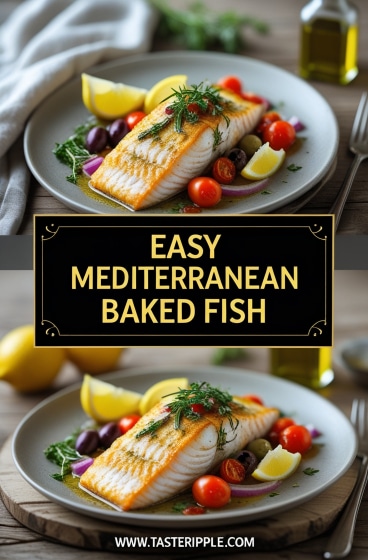I still remember the first time I had baked fish in a little seaside taverna along the coast of Crete. The dish wasn’t complicated, no fancy sauces or heavy butter, just a piece of white fish baked with olive oil, tomatoes, garlic, and herbs. It was so light but bursting with flavor, almost like the sea itself had seasoned it. And yet, when I tried to recreate it back home, I learned that the trick isn’t in the recipe itself—it’s in the way Mediterranean cooking treats ingredients with respect.
This easy Mediterranean baked fish is exactly that: respect on a plate. It’s a recipe that doesn’t try to cover up the fish with too many things. Instead, it celebrates the natural sweetness of fresh fish with olive oil, lemon, herbs, and sun-ripened vegetables. Professionals know that the simplest dishes are often the hardest to perfect, because there’s nowhere to hide mistakes. If you use a fish that isn’t fresh or overbake it by five minutes, the dish loses its magic. But when done right, it’s one of those dishes that feels both rustic and refined at the same time.
Mediterranean baked fish is special for another reason. It’s the kind of recipe that bridges cultures. You’ll find versions of it in Greek kitchens, in Spanish homes, in Italy’s coastal towns, even in North Africa where the flavors lean spicier with cumin and harissa. Each region adds a twist, but the heart of it is always the same: good fish, good olive oil, fresh produce.
Ingredients and Substitutions
Choosing ingredients carefully matters more here than in heavier recipes. Every flavor you put in shows up in the final bite. So, opt for the freshest fish you can get your hands on, and don’t skimp on the olive oil. This dish thrives on high-quality, simple things.
Here’s the ingredient list for a recipe that serves 4 people:
| Ingredient | Measurement | Notes & Substitutions |
|---|---|---|
| White fish fillets (cod, halibut, sea bass, or snapper) | 4 fillets (about 6 oz each) | Can substitute salmon, trout, or tilapia, though flavor shifts slightly |
| Olive oil (extra virgin) | 4 tbsp | Avocado oil works if olive oil unavailable, but Mediterranean flavor less authentic |
| Cherry tomatoes | 2 cups (halved) | Regular tomatoes cut in wedges can be used |
| Red onion | 1 medium (thinly sliced) | Shallots or yellow onion also fine |
| Garlic | 4 cloves (minced) | Garlic powder in a pinch, but fresh gives depth |
| Lemon | 2 (1 sliced, 1 juiced) | Lime can be used, but taste sharper |
| Fresh parsley | ½ cup (chopped) | Fresh cilantro or basil as alternative |
| Dried oregano | 2 tsp | Fresh oregano (1 tbsp) or thyme can be swapped |
| Salt | 1 tsp (adjust to taste) | Sea salt gives better minerality than table salt |
| Black pepper | ½ tsp | Crushed red pepper for a spicier note |
| Kalamata olives | ½ cup (pitted, halved) | Green olives or capers for different briny kick |
A quick note on selection: always prefer fresh herbs to dried when baking fish. Dried herbs tend to mute when exposed to moist heat, while fresh ones release fragrance and brighten the dish. And with olive oil—don’t use the bottom-shelf stuff. A peppery, slightly grassy extra virgin oil makes the dish sing.
Step-by-Step Instructions
Cooking fish can scare even experienced cooks, mostly because it feels unforgiving. Overcook it, and it’s dry. Undercook it, and it’s unsafe. But baked fish is more forgiving than people think, especially when surrounded by juicy vegetables. The trick is even cooking and layering flavors so nothing gets lost.
Step 1: Preheat and Prep
Preheat oven to 400°F (200°C). This temperature is hot enough to caramelize the veggies slightly but gentle enough to cook the fish through without drying it. Line a baking dish with a light brush of olive oil so nothing sticks.
Expert tip: use ceramic or glass baking dishes rather than thin aluminum pans. They distribute heat evenly, which helps avoid overcooking one side of the fillet.
Step 2: Build the Base
Scatter sliced onions, cherry tomatoes, and minced garlic in the dish. Drizzle with half the olive oil, sprinkle with oregano, salt, and pepper. Toss lightly with your hands so everything gets coated. This vegetable base becomes a bed that releases juices, keeping the fish moist.
Common mistake: don’t overload the dish with too many veggies. If the layer is too thick, the fish won’t roast—it’ll steam. That means you lose that gentle caramelization that adds depth.
Step 3: Lay the Fish
Place fish fillets directly over the vegetables. Season with remaining salt, pepper, and oregano. Drizzle the rest of the olive oil, then squeeze lemon juice over the top. Add lemon slices directly on the fillets. This layering helps the fish absorb acidity and perfume while baking.
Variation: if you want a spicier Mediterranean feel, add a teaspoon of smoked paprika or Aleppo pepper to the fish seasoning. It gives warmth without overpowering.
Step 4: Add Olives and Herbs
Scatter olives around and sprinkle half the fresh parsley over everything. Keep the other half for garnish later. The olives infuse a salty brine that balances the sweetness of tomatoes.
Step 5: Bake
Bake uncovered for 15–20 minutes, depending on thickness of fillets. A general rule: fish is done when it flakes easily with a fork and turns opaque in the center. For most white fish, internal temperature should hit 145°F (63°C).
Professional tip: always check at the 15-minute mark. Thin fillets like tilapia may cook through in 12 minutes. Thick halibut or cod may need 20. Better to check twice than dry it out.
Step 6: Rest and Finish
Once out of the oven, let the dish rest for 3–4 minutes. This short rest allows juices to redistribute, making the fish moist instead of watery when cut. Sprinkle with remaining parsley and a small drizzle of fresh olive oil for brightness.
Optional finish: a dusting of crumbled feta cheese right before serving adds creamy tang, very common in Greek versions.
Cooking Techniques and Science
Why bake instead of pan-fry? Baking allows gentle, even heat from all sides, so the fish cooks without breaking apart. Pan-frying gives a crisp crust, yes, but it risks overcooking thin fish. In Mediterranean cuisine, where vegetables and herbs accompany fish, baking is the natural choice—it lets everything cook together and build flavor in the same dish.
The olive oil does more than add richness. Oil helps conduct heat evenly and creates a barrier that prevents the fish from drying. It also dissolves fat-soluble flavor compounds from herbs and lemon zest, spreading them across the dish. That’s chemistry at work—flavors become more available to your tongue because oil carries them.
Tomatoes release glutamic acid when cooked, a natural form of umami. That’s why baked tomatoes taste almost meaty, deepening the dish without adding heavy sauces. Olives add saltiness and fat, balancing acidity from lemon. It’s a triangle of flavor: fat, acid, umami.
Storing and Reheating
This dish keeps surprisingly well. Store leftovers in an airtight container in the fridge for up to 2 days. To reheat, place in a 300°F oven for 10 minutes. Avoid microwaving if possible, since it toughens the fish and ruins texture. If you must microwave, cover with a damp paper towel and heat gently.
Variations and Substitutions
- Vegan version: Replace fish with thick slices of eggplant or zucchini, treated exactly the same way.
- Gluten-free: The dish is naturally gluten-free, but avoid store-bought seasonings with hidden wheat fillers.
- Spicy version: Add harissa paste or crushed red pepper to the vegetable mix for North African flair.
- Luxury version: Add clams or mussels around the fish before baking. They’ll steam open and release briny juices into the base.
Tools That Matter
A sharp knife for slicing onions and filleting fish if needed. A good ceramic or enameled baking dish for heat retention. And a fish spatula, thin and flexible, to lift fillets without tearing them. Professionals swear by it, and once you use one, you’ll never go back.
Serving and Pairing Suggestions
Mediterranean baked fish deserves a table full of color. Serve it straight from the baking dish, rustic style, or plate each fillet on a warm plate with its bed of roasted veggies. A drizzle of extra virgin olive oil right before serving gives it a glossy finish.
For sides, think simple. Crusty bread to soak up juices. A couscous salad with cucumber and mint. Or roasted potatoes with rosemary. If you prefer lighter, a crisp green salad with lemon vinaigrette balances the warmth of the fish.
For drinks, pair with dry white wines like Sauvignon Blanc, Assyrtiko from Greece, or a light Pinot Grigio. If avoiding alcohol, sparkling water with lemon works beautifully, keeping the palate refreshed.
Best Time to Serve
This dish shines at dinner, especially when shared family-style. It feels celebratory but not heavy. Perfect for summer evenings when tomatoes are at their best, or for springtime meals when lighter eating just feels right. Professionals often put this dish on menus during warm months—it sells itself.
Conclusion
Easy Mediterranean baked fish is proof that less really can be more. Fresh fish, olive oil, lemon, and herbs come together into something more than the sum of their parts. It’s the kind of recipe that teaches restraint: you don’t need 15 ingredients when 6 will do the job beautifully.
Key tip: don’t rush ingredient selection. Fish should smell like the ocean, not “fishy.” Olive oil should be bold but balanced. Tomatoes should be ripe enough to burst with juice. Get those right, and the oven will take care of the rest.
Cooking is often about control, but here it’s about trust. Trusting the ingredients, trusting the oven, trusting that something so simple can be stunning. And it always is.
FAQs
1. What’s the best fish for Mediterranean baked fish?
Firm white fish like cod, halibut, or sea bass are ideal. They hold their shape while absorbing flavors.
2. Can I make this dish ahead of time?
You can prep the vegetables and seasoning in advance, but bake the fish just before serving for best texture.
3. Is frozen fish okay for this recipe?
Yes, but thaw it slowly in the fridge overnight. Pat dry well before baking, or the dish may turn watery.
4. How do I know when fish is fully cooked?
It flakes easily with a fork and is opaque throughout. An instant thermometer should read 145°F (63°C).
5. Can I add cheese?
Yes, crumbled feta is a traditional topping. Add it right after baking so it softens into the warm dish without melting completely.

